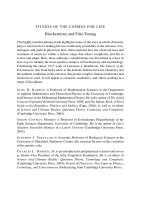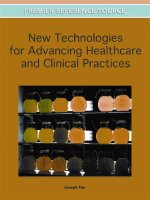UNIT 2. FORMATS FOR ELECTRONIC DOCUMENTS AND IMAGES LESSON 7. CHARACTER ENCODING: LATIN AND NON-LATIN SCRIPTSNOTE pdf
Bạn đang xem bản rút gọn của tài liệu. Xem và tải ngay bản đầy đủ của tài liệu tại đây (879.9 KB, 11 trang )
2. Formats for electronic documents and images - 7. Character encoding: latin and non-latin scripts – page 1
Information Management Resource Kit
Module on Management of
Electronic Documents
UNIT 2. FORMATS FOR ELECTRONIC
DOCUMENTS AND IMAGES
LESSON 7. CHARACTER ENCODING: LATIN AND
NON-LATIN SCRIPTS
© FAO, 2003
NOTE
Please note that this PDF version does not have the interactive features offered
through the IMARK courseware such as exercises with feedback, pop-ups,
animations etc.
We recommend that you take the lesson using the interactive courseware
environment, and use the PDF version for printing the lesson and to use as a
reference after you have completed the course.
2. Formats for electronic documents and images - 7. Character encoding: latin and non-latin scripts page 2
Objectives
At the end of this lesson, you will be able to:
understand how to solve the main problems with
character encoding.
Probably you have at some time or
another opened a web page only to find
illegible text and meaningless characters.
This is a problem connected to character
encoding.
Lets try to understand the causes of this
problem
ƯpêGƯựằ~êƯaÔốĂAẵ
éÔÊĐ[ÊƠXôỹƠĂI
ĂIƯpêGƯÔHƯẵsẵX-ỡz
-êđẹâẻụáẵéÊă
ẹÔ@ÔUƯnảĩĂHèêủÔ
FÔ@Ô
?
Character encoding
2. Formats for electronic documents and images - 7. Character encoding: latin and non-latin scripts – page 3
Character encoding
Character encoding is the organization of
a set of numeric codes that represent all
meaningful characters (single letter, digit,
space, punctuation, etc.) of a script system
in memory.
Each character is stored in memory as a
number.
When a user enters characters, the user's
keypresses are converted to character
codes; when the characters are displayed
on screen, the character codes are
converted to the glyphs of a font.
A = 65
A
65
A
Character encoding
In most character encoding standards,
the character set changes to represent
the language being used, so the upper-
level characters may include symbols,
accented Roman letters, Cyrillic, or
other characters, depending on the
character encoding chosen.
For example, the character "Ó" in the
Macintosh Standard Roman Character
Set is in the same code point 205 as the
equal sign “=“ in Windows extended
ASCII encoding.
205
Ó
=
2. Formats for electronic documents and images - 7. Character encoding: latin and non-latin scripts – page 4
Several encoding systems are available for which encoding schemes have been developed:
7-BIT ENCODING
SYSTEM
8-BIT ENCODING SYSTEM 16-BIT ENCODING SYSTEM 32-BIT ENCODING
SYSTEM
What is An encoding system that
uses a fixed width of 7-bit
encoding that allows for a
character set of 128
values (2
7
).
An encoding system that uses
the eighth bit (parity bit) of the
7-bit encoding system to
cover a larger number of
characters. It allows for the
use of 256 values (2
8
).
An encoding system that uses
a fixed-width of 16 bits per
character, which allows the
accommodation of a total of
65536 (2
16
)values.
Standard named
ISO/IEC 10646-1. It is
essentially a 31-bit
encoding, i.e., 2
31
=
2147483648 code
positions.
Schemes ASCII and ISO 646 are
examples of 7-bit
encoding. In fact, only
English, Latin, and
Swahili languages can
use plain 7-bit ASCII with
no additional
characters. Most
languages based on the
Latin alphabet require
larger code set.
It covers most common
European languages, like
French or German, that have
accented letters, as well as
Arabic and Hebrew. Many
national variants were
developed. To normalize the
mess of 8-bit encodings, ISO
came up with the ISO 8859
series of standards.
It is needed for Asian
languages, such as Chinese
and Japanese that use
ideographs, or hieroglyphs,
instead of letters. Windows
NT, for example, uses 16-bit
internally for all character
values.
This system, also known
as Universal Multiple-
Octet Coded Character
Set (UCS), was
developed as standard
in 1993. Today, most
PCs have 32-bit
registers.
Register sizes are rapidly growing to 64 bits. Special codes are now written for the 64-bit chip
used in Windows XP.
Character encoding
Encoding schemes
As a Webmaster, you must pay
particular attention to the encoding
scheme (also known as character
set) that you use; each scheme
represents characters used in a
different language.
2. Formats for electronic documents and images - 7. Character encoding: latin and non-latin scripts – page 5
It is recommended that you label a
document in the language that it is
written in by using the charset code in
all pages: this will allow browsers to
automatically choose the correct
character type to display,
independently from the workstation
setting.
In this example, the Chinese version of
the FAO Home Page contains a charset
code for Chinese and thus this page is
automatically displayed in Chinese.
Encoding schemes
If you don’t use charset code, your result will be like this:
Encoding schemes
This is the same Chinese web page
seen in the previous example.
In order to see this page in the
correct font, the user needs to
change the document encoding, by
selecting Encoding from the View
Menu and by clicking on Chinese
Simplified.
This is not the best way to present
your information!
2. Formats for electronic documents and images - 7. Character encoding: latin and non-latin scripts – page 6
Using the charset code, you can insert, edit or update text in an HTML page in the original
language of that page.
The charset code must be included in your HTML page by inserting the following META tags:
English, French, Spanish:
<meta http-equiv=“Content-Type" content="text/html;charset=ISO-8859-1">
Chinese:
<meta http-equiv=“Content-Type" content="text/html; charset=gb2312">
Arabic:
<meta http-equiv=“Content-Type" content="text/html;charset=windows-1256">
These META tags must be inserted in the HEAD section within the <HEAD> and </HEAD>
sections of the HTML page.
Encoding schemes
You can also use UTF-8 (Unicode
Transformation Format, 8-bit encoding
form) as encoding, especially when
you have to mix languages freely on
the same page.
UTF-8 is an encoding form of the
Unicode Standard, the universal
character encoding standard used for
representation of text for computer
processing.
The Unicode Standard provides the
capacity to encode all of the
characters used for the written
languages of the world.
One disadvantage of Unicode is that it
takes more space to store plain text
and transmission of Unicode data can
therefore use more bandwidth.
Encoding schemes
2. Formats for electronic documents and images - 7. Character encoding: latin and non-latin scripts – page 7
Encoding schemes
More information about Unicode
Unicode is now widely used and has become the preferred character set for the
Internet, especially for developing, processing and exchanging multilingual
HTML and XML documents, and it is also being adopted for use in e-mail.
However, Unicode is not the most common character set in use. According to
Microsoft, there is "built-in" support for Unicode in Windows NT and Windows
2000, but only limited support in Windows 95 and Windows 98. In addition,
older office automation software such as Office 97, do not offer Unicode
options.
For pages written, for example, in Arabic, the
direction in which the text is to be displayed must
be specified.
Arabic encoding can appear as follows:
<HTML dir="RTL" lang="ar">
<HEAD>
<meta http-equiv="Content-Type"
content="text/html; charset=windows-1256">
</HEAD>
RTL means from right to left.
If you have a mixed language page, you will need to
use spans to enclose the Arabic content.
Using span tags (<SPAN>, </SPAN>), you can
separate the document into different paragraphs, and
apply the RTL only to the Arabic parts.
Encoding schemes
2. Formats for electronic documents and images - 7. Character encoding: latin and non-latin scripts – page 8
In order to maintain original characters when converting Arabic and Chinese Word
documents into HTML on non-Arabic and non-Chinese workstations, certain procedures
need to be followed.
Descriptions of these procedures can be downloaded and printed below (note: procedures
based on the usage of charset=windows-1256 for Arabic and charset=gb2312 for Chinese):
Converting an Arabic document into HTML on a non-Arabic workstation.
Converting a Chinese document into HTML on a non-Chinese workstation.
Procedures similar to the ones described above for Arabic and Chinese documents, can be
applied to other documents written in non-Latin characters (e.g. Russian documents).
The appropriate charsets need to be inserted.
Guidelines and procedures
Summary
• In computers, characters are stored in memory as numbers.
• Characters can be coded in different ways (encoding schemes).
• As a Webmaster, you must specify which encoding scheme you are
using in order to correctly display the text of your document on the Web.
• You must pay particular attention when converting Arabic and Chinese
Word documents into HTML on non-Arabic and non-Chinese
workstations.
2. Formats for electronic documents and images - 7. Character encoding: latin and non-latin scripts – page 9
Exercises
The following three exercises will test your understanding of the concepts covered in the lesson and
provide you with feedback.
Good luck!
Click on your answer
You created a web page in Arabic using a charset code. However, your page is being displayed
on an English language workstation.
How will your page look?
Exercise 1
2. Formats for electronic documents and images - 7. Character encoding: latin and non-latin scripts – page 10
Click on your answer
What is the function of a charset code?
Exercise 2
It allows you to translate text from an HTML page into a specific
language.
It allows browsers to automatically select the correct character
type to display.
It allows the user to select the correct character type in which to
display the Web page.
Click on your answer
<HTML dir="RTL"
lang="ar">
<HEAD>
<meta http-
equiv="Content-Type"
content="text/html;
charset=windows-
1256">
</HEAD>
Exercise 3
<HTML dir="LTR"
lang="ar">
<HEAD>
<meta http-
equiv="Content-Type"
content="text/html;
charset=windows-
1256">
</HEAD>
<HTML dir=“RTL"
lang="ar">
<HEAD>
<meta http-
equiv="Content-Type"
content="text/html;
charset=ISO-8859-1">
</HEAD>
Which of the following examples of HTML script is correct for a Web page written in Arabic?
2. Formats for electronic documents and images - 7. Character encoding: latin and non-latin scripts – page 11
If you want to know more
Download and print documents for more information on:
ASCII, ISO 8859-1, Unicode and ISO 10646
Windows and code pages
XML and E-mail encoding
American National Standards Institute (ANSI) />HTML4-“ HTML 4.01 Specification” />HTTP1.1- “RFC2068 Hypertext Transfer Protocol—HTTP/1.1”
/>International Organization for Standardization (ISO) />International Electrotechnical Commission (IEC) />Unicode Consortium />Unicode Technical Report #17: Character Encoding Model.
/>Windows Character Set
/>World Wide Web Consortium (W3C) />XML- “Extensible Markup Language (XML) 1.0 (Second Edition)”-
/>









